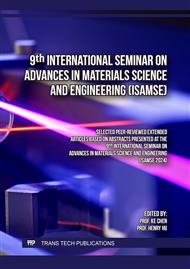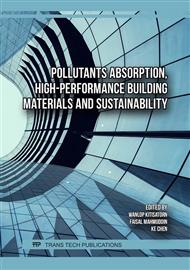[1]
LYU Zhengye, ZHANG Yanbo, LIU Ze, et al. Properties of Red Mud-Based Foamed Geopolymer [J]. Bulletin of the Chinese Ceramic Society, 2023, 42(10): 3624.
Google Scholar
[2]
Zeng H, Liu F, Sun W, et al. Progress on the industrial applications of red mud with a focus on China [J]. Minerals, 2020, 10(9): 773.
Google Scholar
[3]
Jakab M, Patthy G B, Korim T, et al. Investigation of the Usability of Reduced Alkalinity Red Mud in the Building Material Industry [J]. Resources, 2023, 12(7): 79.
DOI: 10.3390/resources12070079
Google Scholar
[4]
Wang Q, Han S, Yang J, et al. Preparation of geopolymer concrete with Bayer red mud and its reaction mechanism [J]. Construction and Building Materials, 2023, 409: 133730.
DOI: 10.1016/j.conbuildmat.2023.133730
Google Scholar
[5]
Lin H, Liu H, Li Y, et al. Properties and reaction mechanism of phosphoric acid activated metakaolin geopolymer at varied curing temperatures [J]. Cement and Concrete Research, 2021, 144: 106425.
DOI: 10.1016/j.cemconres.2021.106425
Google Scholar
[6]
Louati S, Baklouti S, Samet B. Acid based geopolymerization kinetics: effect of clay particle size [J] Applied Clay Science, 2016, 132: 571-578.
DOI: 10.1016/j.clay.2016.08.007
Google Scholar
[7]
Zribi M, Samet B, Baklouti S. Mechanical, microstructural and structural investigation of phosphate-based geopolymers with respect to P/Al molar ratio [J]. Journal of Solid State Chemistry, 2020, 281: 121025.
DOI: 10.1016/j.jssc.2019.121025
Google Scholar
[8]
AlJaberi F Y. Studies of autocatalytic electrocoagulation reactor for lead removal from simulated wastewater [J]. Journal of Environmental Chemical Engineering, 2018, 6(5): 6069-6078.
DOI: 10.1016/j.jece.2018.09.032
Google Scholar
[9]
Zulfiqar U, Farooq M, Hussain S, et al. Lead toxicity in plants: Impacts and remediation [J]. Journal of Environmental Management, 2019, 250: 109557.
DOI: 10.1016/j.jenvman.2019.109557
Google Scholar
[10]
Hussin F, Abnisa F, Issabayeva G, et al. Removal of lead by solar-photovoltaic electrocoagulation using novel perforated zinc electrode [J]. Journal of Cleaner Production, 2017, 147: 206-216.
DOI: 10.1016/j.jclepro.2017.01.096
Google Scholar
[11]
IS10500 B I S. Indian standard drinking water–specification (second revision) [J]. Bureau of Indian Standards (BIS), New Delhi, 2012: 1-11.
Google Scholar



